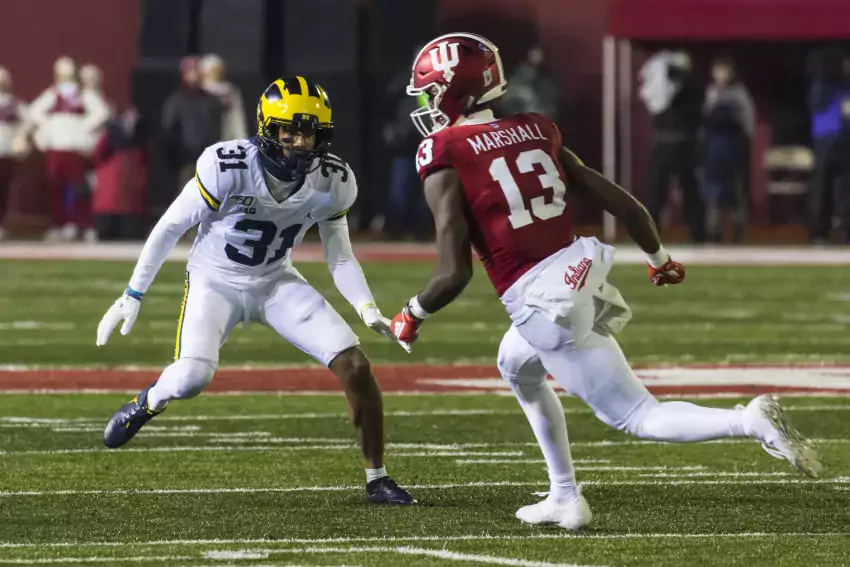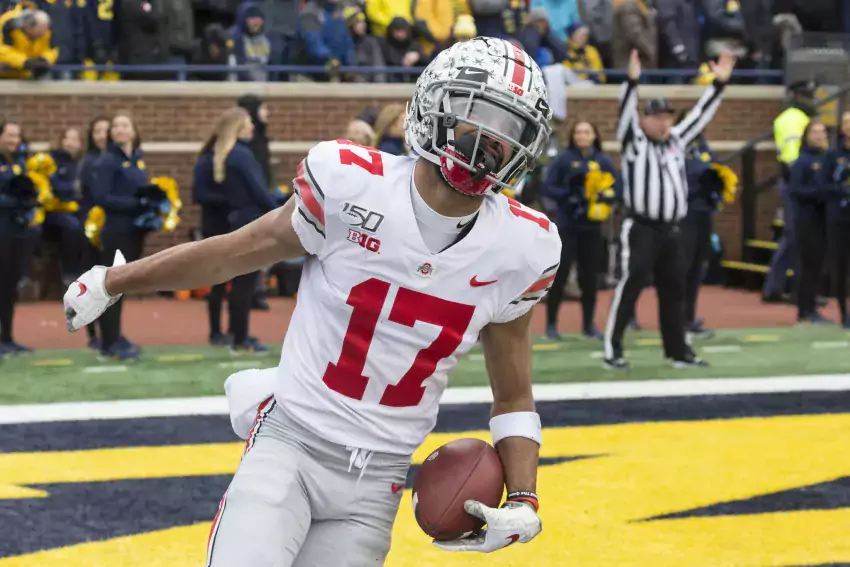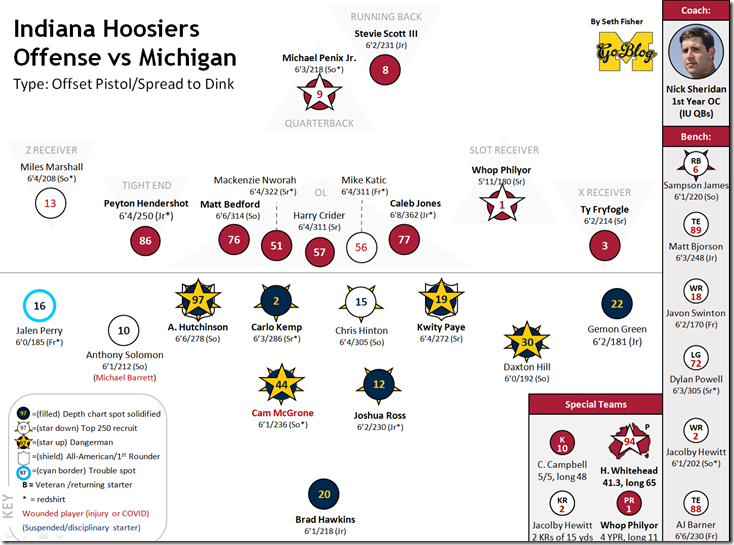whop philyor

Resources: My charting, IU game notes, IU roster, CFBstats, Last year
Last year the Hoosiers lost Michael Penix early and got used to the light touch of Peyton Ramsey. This year you can tell. Penix is throwing 100 mph darts, and a couple of times his receivers flat-out dropped them because they couldn't believe a ball could travel so fast. Especially from that arm angle. Once they adjusted, hooooo boy there were some tight windows. Penix is a thrill. Not just for sophomoric beat writers either.
The film: I'm not doing more Rutgers nope nope nope plus IU-Penn State was fuuuuuuun.
Personnel:
PDF version, full-size version (or click on the image)
Reminder that the solid colors mean the guy's the solid #1 starter, and bolded names are veterans. Most of these guys are the same as last year. You remember Mike Hart but Big RB #8 Stevie Scott III, and speedy little slot #1 Whop Philyor, by reputation if not sight, because he's had a habit of being unavailable when they play Michigan. Scott's backup RB #6 Sampson James is the only 4-star playing, and isn't too different from Scott.
"The wide receivers fortunately did not look like the world-beaters IU always seems to turn up," would be my famous last words if I was dumb enough to say such a thing. Without taking anything away from secret five-star factory Michigan State, Indiana's WR room was at least considered an upgrade on East Lansing's, and looked like it against common opponent Rutgers. PSU got handsy, especially against Whop, but even with the flurry of "refs-2"s that IU suffered in my charting, longtime up-and-comer WR #3 Ty Fryfogle was responsible for as much bad as good in the passing game, and is not a blocker. He was a very effective receiver last year, matching Ronnie Bell's YPT (10.6) and Fryfogle's 72% catch rate bettered Ronnie's by 11 points, albeit on a much lower target rate. The other three guys, tall WR #13 Miles Marshall, fast-ish WR #2 Jacolby Hewitt, and playmaking freshman #18 Javon Swinton are all at least 6'2" and rotated evenly. None were getting much separation from PSU's corners, neither of whom gave up 200 yards to an MSU freshman recently.
[After THE JUMP: the players and analysis.]

Previously: Quarterback, Running Back
I'm bringing back this preview feature from before my time off; the exercise is to rank Michigan's opponents, as well as the Wolverines themselves, in each position group. This is particularly useful to do in a year when roster turnover and late-offseason changes (laaaaaaaaaaaaaate-offseason changes) are so prevalent; I'll do my best in these posts to highlight significant opt-outs, opt-ins, and the like.
The series continues with a look at the pass-catchers on this year's schedule. Sorry for several of the photos. Projected starters are in bold, backups in italics.
Tier I: They're Coaching The Five-Stars
 (sigh) [Bryan Fuller]
(sigh) [Bryan Fuller]
1. Ohio State. Bah.
Fine, details. While KJ Hill, Binjimen Victor, and Austin Mack are gone—add in RB JK Dobbins and OSU is down four of their top six receivers from 2019—there's a good chance this unit is better than last year.
I probably don't need to remind you that Michigan got an unwelcome preview of what's to come when Chris Olave and Garrett Wilson both scored long touchdowns in The Game last season. Olave is a smooth outside receiver and potential early-round pick if he enters the NFL Draft in 2021. Wilson is a spectacular athlete who'll get to spend much more time at his more natural slot position with Hill out of the way.
I'm inclined to say those two will outperform their graduated but less talented teammates; Hill went in the seventh round of the draft while Victor and Mack weren't selected but they were the experienced options in an egalitarian passing attack. But, well, you've probably noticed that OSU has added some talent of late, and a whole lot of that talent is at wide receiver:
Just for a fun exercise, if you remove [2017 three-star Ellijah] Gardiner from the equation — no offense, he’s just the lowest-rated player — the average score for this group would be 0.9616. In other words, the average receiver on the OSU roster would be ranked No. 86 in the current recruiting class. And we’re talking about 10 players. The number is only that low because Olave, one of the top receiver prospects in this draft cycle, wasn’t evaluated properly coming out of high school.
If Olave and Wilson don't put up huge numbers it's probably because too many other future NFL players also earned targets. The most likely additional contributors behind them are sophomore Jameson Williams (#82 overall 2019 prospect) and four true freshmen: Julian Fleming (#3 in 2020), Jaxon Smith-Njigba (#29), Gee Scott Jr. (#66), and Mookie Cooper (#93).
While recent OSU offenses haven't featured the tight end, they should get efficient play out of—you guessed it—some former blue-chip recruits. Jeremy Ruckert, the #2 TE in the 2018 class, scored on four of his 14 receptions in 2019. Jake Hausmann (#4 TE in 2016) and Luke Farrell (#7 in 2016) are reliable blockers in frequently deployed two-TE sets; Farrell has also shown some seam-stretching ability in his limited receiving opportunities.
Unlike a certain disgraced former receivers coach, Brian Hartline looks like he's actually coaching the high-level talent at his disposal. He may have the best receivers room in the country. Eat at Arby's.
[Hit THE JUMP because it can't be more of a bummer than that, at least.]

42